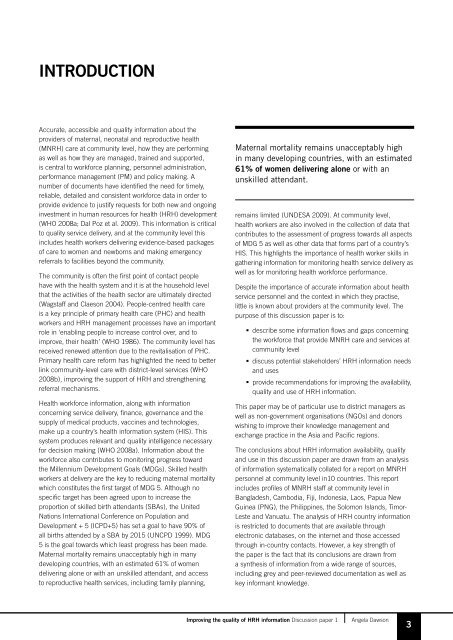improving the quality of hrh information - HRH Knowledge Hub ...
improving the quality of hrh information - HRH Knowledge Hub ...
improving the quality of hrh information - HRH Knowledge Hub ...
You also want an ePaper? Increase the reach of your titles
YUMPU automatically turns print PDFs into web optimized ePapers that Google loves.
Introduction<br />
Accurate, accessible and <strong>quality</strong> <strong>information</strong> about <strong>the</strong><br />
providers <strong>of</strong> maternal, neonatal and reproductive health<br />
(MNRH) care at community level, how <strong>the</strong>y are performing<br />
as well as how <strong>the</strong>y are managed, trained and supported,<br />
is central to workforce planning, personnel administration,<br />
performance management (PM) and policy making. A<br />
number <strong>of</strong> documents have identified <strong>the</strong> need for timely,<br />
reliable, detailed and consistent workforce data in order to<br />
provide evidence to justify requests for both new and ongoing<br />
investment in human resources for health (<strong>HRH</strong>) development<br />
(WHO 2008a; Dal Poz et al. 2009). This <strong>information</strong> is critical<br />
to <strong>quality</strong> service delivery, and at <strong>the</strong> community level this<br />
includes health workers delivering evidence-based packages<br />
<strong>of</strong> care to women and newborns and making emergency<br />
referrals to facilities beyond <strong>the</strong> community.<br />
The community is <strong>of</strong>ten <strong>the</strong> first point <strong>of</strong> contact people<br />
have with <strong>the</strong> health system and it is at <strong>the</strong> household level<br />
that <strong>the</strong> activities <strong>of</strong> <strong>the</strong> health sector are ultimately directed<br />
(Wagstaff and Claeson 2004). People-centred health care<br />
is a key principle <strong>of</strong> primary health care (PHC) and health<br />
workers and <strong>HRH</strong> management processes have an important<br />
role in ‘enabling people to increase control over, and to<br />
improve, <strong>the</strong>ir health’ (WHO 1986). The community level has<br />
received renewed attention due to <strong>the</strong> revitalisation <strong>of</strong> PHC.<br />
Primary health care reform has highlighted <strong>the</strong> need to better<br />
link community-level care with district-level services (WHO<br />
2008b), <strong>improving</strong> <strong>the</strong> support <strong>of</strong> <strong>HRH</strong> and streng<strong>the</strong>ning<br />
referral mechanisms.<br />
Health workforce <strong>information</strong>, along with <strong>information</strong><br />
concerning service delivery, finance, governance and <strong>the</strong><br />
supply <strong>of</strong> medical products, vaccines and technologies,<br />
make up a country’s health <strong>information</strong> system (HIS). This<br />
system produces relevant and <strong>quality</strong> intelligence necessary<br />
for decision making (WHO 2008a). Information about <strong>the</strong><br />
workforce also contributes to monitoring progress toward<br />
<strong>the</strong> Millennium Development Goals (MDGs). Skilled health<br />
workers at delivery are <strong>the</strong> key to reducing maternal mortality<br />
which constitutes <strong>the</strong> first target <strong>of</strong> MDG 5. Although no<br />
specific target has been agreed upon to increase <strong>the</strong><br />
proportion <strong>of</strong> skilled birth attendants (SBAs), <strong>the</strong> United<br />
Nations International Conference on Population and<br />
Development + 5 (ICPD+5) has set a goal to have 90% <strong>of</strong><br />
all births attended by a SBA by 2015 (UNCPD 1999). MDG<br />
5 is <strong>the</strong> goal towards which least progress has been made.<br />
Maternal mortality remains unacceptably high in many<br />
developing countries, with an estimated 61% <strong>of</strong> women<br />
delivering alone or with an unskilled attendant, and access<br />
to reproductive health services, including family planning,<br />
Maternal mortality remains unacceptably high<br />
in many developing countries, with an estimated<br />
61% <strong>of</strong> women delivering alone or with an<br />
unskilled attendant.<br />
remains limited (UNDESA 2009). At community level,<br />
health workers are also involved in <strong>the</strong> collection <strong>of</strong> data that<br />
contributes to <strong>the</strong> assessment <strong>of</strong> progress towards all aspects<br />
<strong>of</strong> MDG 5 as well as o<strong>the</strong>r data that forms part <strong>of</strong> a country’s<br />
HIS. This highlights <strong>the</strong> importance <strong>of</strong> health worker skills in<br />
ga<strong>the</strong>ring <strong>information</strong> for monitoring health service delivery as<br />
well as for monitoring health workforce performance.<br />
Despite <strong>the</strong> importance <strong>of</strong> accurate <strong>information</strong> about health<br />
service personnel and <strong>the</strong> context in which <strong>the</strong>y practise,<br />
little is known about providers at <strong>the</strong> community level. The<br />
purpose <strong>of</strong> this discussion paper is to:<br />
• describe some <strong>information</strong> flows and gaps concerning<br />
<strong>the</strong> workforce that provide MNRH care and services at<br />
community level<br />
• discuss potential stakeholders’ <strong>HRH</strong> <strong>information</strong> needs<br />
and uses<br />
• provide recommendations for <strong>improving</strong> <strong>the</strong> availability,<br />
<strong>quality</strong> and use <strong>of</strong> <strong>HRH</strong> <strong>information</strong>.<br />
This paper may be <strong>of</strong> particular use to district managers as<br />
well as non-government organisations (NGOs) and donors<br />
wishing to improve <strong>the</strong>ir knowledge management and<br />
exchange practice in <strong>the</strong> Asia and Pacific regions.<br />
The conclusions about <strong>HRH</strong> <strong>information</strong> availability, <strong>quality</strong><br />
and use in this discussion paper are drawn from an analysis<br />
<strong>of</strong> <strong>information</strong> systematically collated for a report on MNRH<br />
personnel at community level in10 countries. This report<br />
includes pr<strong>of</strong>iles <strong>of</strong> MNRH staff at community level in<br />
Bangladesh, Cambodia, Fiji, Indonesia, Laos, Papua New<br />
Guinea (PNG), <strong>the</strong> Philippines, <strong>the</strong> Solomon Islands, Timor-<br />
Leste and Vanuatu. The analysis <strong>of</strong> <strong>HRH</strong> country <strong>information</strong><br />
is restricted to documents that are available through<br />
electronic databases, on <strong>the</strong> internet and those accessed<br />
through in-country contacts. However, a key strength <strong>of</strong><br />
<strong>the</strong> paper is <strong>the</strong> fact that its conclusions are drawn from<br />
a syn<strong>the</strong>sis <strong>of</strong> <strong>information</strong> from a wide range <strong>of</strong> sources,<br />
including grey and peer-reviewed documentation as well as<br />
key informant knowledge.<br />
Improving <strong>the</strong> <strong>quality</strong> <strong>of</strong> <strong>HRH</strong> <strong>information</strong> Discussion paper 1<br />
Angela Dawson<br />
3

















